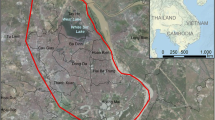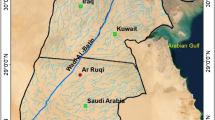Abstract
Gaza coastal aquifer (GCA) is the most precious natural source where it is the only source of water for different uses. Groundwater crisis in Gaza includes two major folds: shortage of water supply and contamination. The extraction of groundwater currently exceeds the aquifer recharge rate. As a result, the groundwater level is falling continuously leading severely deterioration of GCA. The main objective of this study is to analyze and evaluate the current and proposed water resources management plans and their effect on the water level of GCA. In this respect, the available quantities of rainfall that could be harvested and infiltrated from different types of land-use based on existing and planned situations are studied using GIS tool and numerical models for GCA using V-MODFLOW environment for simulating four scenarios: (i) existing management practice (no action scenario), (ii) proposed Palestinian Water Authority (PWA) stormwater infiltration plan, (iii) proposed Gaza Emergency Technical Assistance Program (GETAP) interventions, and (iv) combination between second and third scenarios. The management scenarios were tested with the calibrated flow model for the target period between 2016 and 2040. The simulation results of existing management practice scenario show that there are several depression zones in Gaza Strip; in southern part from − 18 to − 24 m MSL in 2020 and 2040, in the northern part from − 7 to − 12 m MSL in 2020 and 2040, and in the middle regions experienced a small decline in groundwater level. The simulation results of proposed PWA scenario indicate similar depression zones as per first scenario but with good enhancement of water level, − 17 to − 18 m MSL in the southern part and − 3 to − 6 m MSL in the northern part in 2020 and 2040, respectively. The simulation results of GETAP intervention scenario show a positive impact on groundwater level. The results of fourth scenario show good enhancement of water level, in which the water level in the northern part ranges from + 3 to + 6 m MSL in 2020 and 2040, while in the south part ranges from − 15 to + 4 MSL in 2020 and 2040.


















Similar content being viewed by others
References
Abu Samra, S. (2014). Determination of physico-chemical properties of top soil in Gaza Strip for agricultural purposes. Master’s Thesis, The Islamic University of Gaza, Palestine, 97p
Almasry MN (2008) Assessment of intrinsic vulnerability to contamination for Gaza coastal aquifer, Palestine. J Environ Manag 88(4):577–593. https://doi.org/10.1016/j.jenvman.2007.01.022
Alnahhal, S. (2009). Recharge assessment and modeling issues to the north of Wadi Gaza coastal aquifer. Master thesis, The Islamic University of Gaza, Palestine, 139p
Al-Najar H, Al-Dalou F, Snounu I, Al-Dadah J (2014) Framework analysis of socio-economic and health aspects of nitrate pollution from urban agricultural practices: the Gaza Strip as a case study. J Agric Environ Sci 3:355–370
Al-Ramlawi (2014) Modeling & monitoring the impact of storm water artificial recharge on groundwater. Case study Beit Lahia municipality infiltration basin. The Islamic University of Gaza, Palestine
Baalousha H (2008) Analysis of nitrate occurrence and distribution in groundwater in the Gaza Strip using major ion chemistry. Global NEST J 10:337–349
Coastal Municipalities Water Utility, CMWU (2009) Status of wastewater in Gaza Strip. CMWU, Palestine
Franke, O., Reilly T. (1987). The effects of boundary conditions on the steady state response of three hypothetical ground-water systems results and implications of numerical experiments. U.S. Geological Survey, Water-Supply Paper 2315, 23p. https://pubs.usgs.gov/wsp/wsp_2315/pdf/wsp_2315.pdf
Gallopin G (2002) Planning for resilience: scenarios, surprises and branch points. In: Gunderson L, Holling CS (eds) Panarchy: understanding transformations in natural and human systems. Island Press, Washington, pp 361–394
Gharbia SS, Aish A, Pilla F (2015) Modelling potential impacts of climate change on groundwater of the Gaza coastal aquifer from ensemble of global climate model projections. Civil Environ Res 7:44–60
Goldenberg, L.C. (1992). Evaluation of the water balance in the Gaza Strip. Geological Survey, Report TR-GSI/16/92 (in Hebrew)
Greitzer D (1967) The effect of soil landscape and Quaternary geology on the distribution of saline and fresh water aquifers in the Coastal Plain of Israel. Tahal Ltd., Water Planning for Israel, Israel
Gvirtzman G, Shachnai E, Bakler N, Ilani S (1985) Stratigraphy of the Kurkar group (Quaternary) of the coastal plain of Israel. Geol Surv Israel, Curr Res 1983/1984:70–82
Hamdan S, Troeger U, Nassar A (2011) Quality risks of storm water harvesting in Gaza. J Environ Sci Technol Gaza 4:55–64
Hassan AE, Bekhit HM, Chapman JB (2009) Using Markov Chain Monte Carlo to quantify parameter uncertainty and its effect on predictions of a groundwater flow model. Environ Model Softw 24(6):749–763. https://doi.org/10.1016/j.envsoft.2008.11.002
Legates DR, McCabe GJ (1999) Evaluating the use of “goodness-of-fit” measures in hydrologic and hydroclimatic model validation. Water Resour Res 35(1):233–241. https://doi.org/10.1029/1998WR900018
Marta D, Deidda R, Paniconi C, Qahman K, Lecca G (2014) A simulation/optimization study to assess seawater intrusion management strategies for the Gaza Strip coastal aquifer (Palestine). Hydrogeol J 1:1–16
Melloul AJ, Collin M (1994) The hydrological malaise of the Gaza Strip. Isr J Earth Sci 43:105–116
Messerschmid, C. (2011). Water in Gaza: problems and prospects. Birzeit University working series 2011/19 (ENG) conferences & public events module. Birzeit university, Palestine, January, 2011
Ministry of Agriculture, MOA (2015) Rainfall official records in 2015. MOA, Palestine
Ministry of Planning and International Cooperation, MOPIC (1994) Gaza environmental profile, part one: inventory of resources. Environmental Planning Directorate, Palestine
Ministry of Transport and Communications, MTC (2005) Data bank from Gaza meteorological station. MTC, Palestine
Narula KK, Gosain AK (2013) Modeling hydrology, groundwater recharge and non-point nitrate loadings in the Himalayan Upper Yamuna Basin. Sci Total Environ 468:102–116
Palestinian Central Bureau of Statistics, PCBS (2006) Projected population in the Palestinian territory. PCBS, Palestine
Palestinian Central Bureau of Statistics, PCBS (2016) Palestinians at the end of 2016. PCBS, Palestine
Palestinian Water Authority, PWA (2000) Coastal aquifer management program, CAMP, integrated aquifer management plan (task 7). PWA, Palestine
Palestinian Water Authority, PWA (2010) Setting-up groundwater protection plan of the coastal aquifer of Gaza strip. PWA-WB-GEWP-01/09. PWA, Palestine
Palestinian Water Authority, PWA (2011) The Gaza Emergency Technical Assistance Programme (GETAP) on water supply to the Gaza Strip, the Comparative Study of Options for an Additional Supply of Water for the Gaza Strip (CSO-G), the updated final report. PWA, Palestine
Palestinian Water Authority, PWA (2014) Environmental and social impact assessment and environmental and social management plan for Gaza water supply and sewage systems improvement project. PWA, Palestine
Palestinian Water Authority, PWA (2015) Water resources status summary report/Gaza Strip. PWA, Palestine
Qahman K, Larabi A (2006) Evaluation and numerical modeling of seawater intrusion in the Gaza aquifer (Palestine). Hydrogeol J 14:713–728. https://doi.org/10.1007/s10040-005-003-2
Qahman K, Larabi A, Ouazar D, Naji A, Alexander H, Cheng D (2009) Optimal and sustainable extraction of groundwater in coastal aquifers. Stoch Environ Res Risk Assess 19:99–110
Reilly, T. (2001). System and boundary conceptualization in ground-water flow simulation: techniques of water-resources investigations of U.S. geological survey, book 3, Chapter B8, 26p
Schwartz F, Zhang H (2003) Fundamentals of ground water. Wiley, Hoboken 592p
Shomar B, Osenbrück K, Yahya A (2008) Elevated nitrate levels in the groundwater of the Gaza Strip: distribution and sources. Sci Total Environ 398(1-3):164–174. https://doi.org/10.1016/j.scitotenv.2008.02.054
UNICEF (2011) Protecting children from unsafe water in Gaza: strategy, action plan and project resources. UNICEF, Occupied Palestinian Territory, New York City 46p
Vengosh A, Kloppmann W, Marei A, Livshitz Y, Gutierrez A, Banna M, Guerrot C, Wienthal I, Vengosh A, Marei A, Gutierrez A, Kloppmann W (2005) The water crisis in the Gaza Strip: prospects for resolution. Ground Water 43:653–660
Wienthal I, Vengosh A, Marei A, Gutierrez A, Kloppmann W (2005) The water crisis in the Gaza Strip: Prospects for resolution. Ground Water 43:653–660
Acknowledgements
Thank goes to the Middle East Desalination Research Center (MEDRC) and Palestinian Water Authority (PWA) for the partial financial support of this work.
Author information
Authors and Affiliations
Corresponding author
Rights and permissions
About this article
Cite this article
Abualtayef, M., Rahman, G.A., Snounu, I. et al. Evaluation of the effect of water management interventions on water level of Gaza coastal aquifer. Arab J Geosci 10, 555 (2017). https://doi.org/10.1007/s12517-017-3329-x
Received:
Accepted:
Published:
DOI: https://doi.org/10.1007/s12517-017-3329-x




